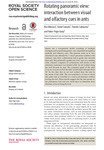Rotating panoramic view
| dc.contributor.author | Minoura, Mai | en_US |
| dc.contributor.author | Sonoda, Kohei | en_US |
| dc.contributor.author | Sakiyama, Tomoko | en_US |
| dc.date.accessioned | 2016-07-04T03:49:01Z | |
| dc.date.available | 2016-07-04T03:49:01Z | |
| dc.date.issued | 2016 | en_US |
| dc.identifier.other | HPU4160317 | en_US |
| dc.identifier.uri | https://lib.hpu.edu.vn/handle/123456789/21886 | |
| dc.description.abstract | Insects use a navigational toolkit consisting of multiple strategies such as path integration, view-dependent recognition methods and olfactory cues. The question arises as to how directional cues afforded by a visual panorama combine with olfactory cues from a pheromone trail to guide ants towards their nest. We positioned a garden antLasius nigeron a rotating table, whereon a segment of a pheromone trail relative to the stationary panorama was rotated while the ant walked along the trail towards its nest | en_US |
| dc.format.extent | 11 p. | en_US |
| dc.format.mimetype | application/pdf | |
| dc.language.iso | en | en_US |
| dc.subject | Biology | en_US |
| dc.subject | Behaviour, Cognition | en_US |
| dc.subject | Ecology | en_US |
| dc.subject | Foraging | en_US |
| dc.subject | Ant | en_US |
| dc.subject | Landmark | en_US |
| dc.title | Rotating panoramic view | en_US |
| dc.type | Article | en_US |
| dc.size | 1.04MB | en_US |
| dc.department | Education | en_US |
Files in this item
This item appears in the following Collection(s)
-
Education [806]

